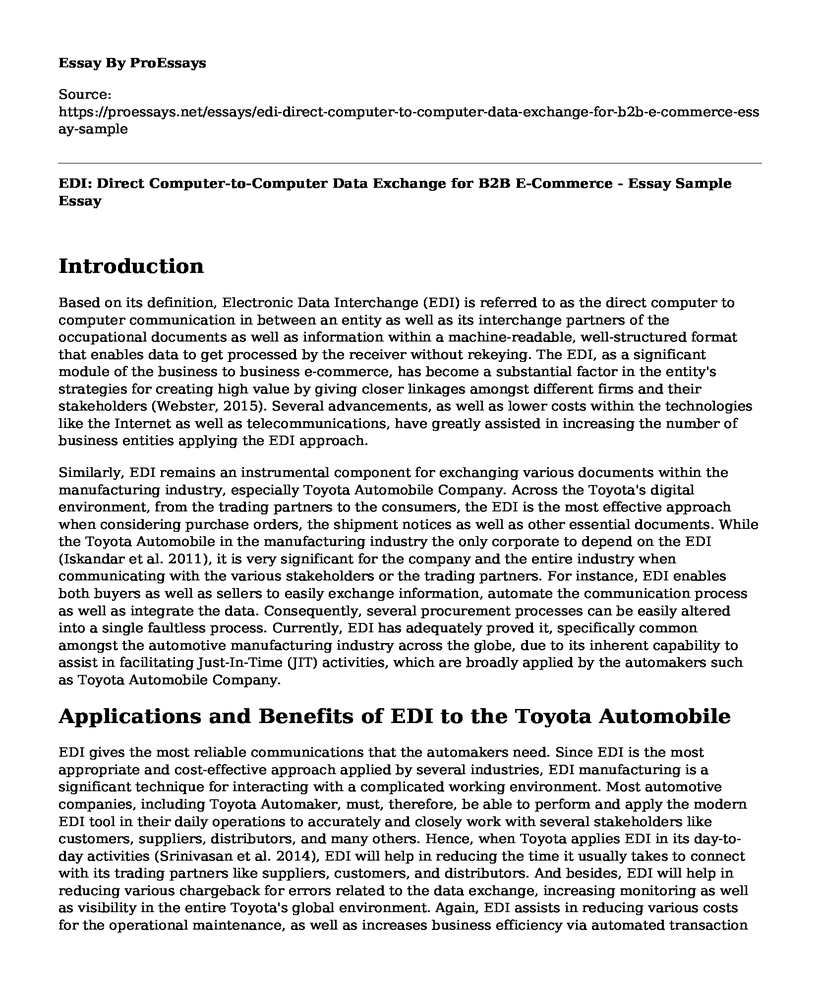Introduction
Based on its definition, Electronic Data Interchange (EDI) is referred to as the direct computer to computer communication in between an entity as well as its interchange partners of the occupational documents as well as information within a machine-readable, well-structured format that enables data to get processed by the receiver without rekeying. The EDI, as a significant module of the business to business e-commerce, has become a substantial factor in the entity's strategies for creating high value by giving closer linkages amongst different firms and their stakeholders (Webster, 2015). Several advancements, as well as lower costs within the technologies like the Internet as well as telecommunications, have greatly assisted in increasing the number of business entities applying the EDI approach.
Similarly, EDI remains an instrumental component for exchanging various documents within the manufacturing industry, especially Toyota Automobile Company. Across the Toyota's digital environment, from the trading partners to the consumers, the EDI is the most effective approach when considering purchase orders, the shipment notices as well as other essential documents. While the Toyota Automobile in the manufacturing industry the only corporate to depend on the EDI (Iskandar et al. 2011), it is very significant for the company and the entire industry when communicating with the various stakeholders or the trading partners. For instance, EDI enables both buyers as well as sellers to easily exchange information, automate the communication process as well as integrate the data. Consequently, several procurement processes can be easily altered into a single faultless process. Currently, EDI has adequately proved it, specifically common amongst the automotive manufacturing industry across the globe, due to its inherent capability to assist in facilitating Just-In-Time (JIT) activities, which are broadly applied by the automakers such as Toyota Automobile Company.
Applications and Benefits of EDI to the Toyota Automobile
EDI gives the most reliable communications that the automakers need. Since EDI is the most appropriate and cost-effective approach applied by several industries, EDI manufacturing is a significant technique for interacting with a complicated working environment. Most automotive companies, including Toyota Automaker, must, therefore, be able to perform and apply the modern EDI tool in their daily operations to accurately and closely work with several stakeholders like customers, suppliers, distributors, and many others. Hence, when Toyota applies EDI in its day-to-day activities (Srinivasan et al. 2014), EDI will help in reducing the time it usually takes to connect with its trading partners like suppliers, customers, and distributors. And besides, EDI will help in reducing various chargeback for errors related to the data exchange, increasing monitoring as well as visibility in the entire Toyota's global environment. Again, EDI assists in reducing various costs for the operational maintenance, as well as increases business efficiency via automated transaction workflow.
Additionally, applying the EDI tool in its daily operations, Toyota automaker has been able to reduce dependence on manual data entry as well as a reduced number of data errors. Lastly, the outsourcing EDI has a controlled service with the trusted vendor, enables automobile companies like Toyota to regain full control of their most essential data exchanges and gain visibility aspect into their daily activities.
Conclusion
Generally, the modern EDI technique is the main reason for the successful strategy of digital transformation amongst industries. EDI provides various companies with the flexibility to help in reshaping how they apply technology to enhance interaction with the trading partners like customers, vendors, suppliers, distributors, and the government. EDI also plays a significant role by ensuring active business to business integration abilities, which include data transformation in the organization. Hence, EDI ensures proper workflow within the automobile industry.
References
Iskandar, B. Y., Kurokawa, S., & LeBlanc, L. J. (2011). Adoption of electronic data interchange: the role of buyer-supplier relationships. IEEE Transactions on Engineering Management, 48(4), 505-517.
Srinivasan, K., Kekre, S., & Mukhopadhyay, T. (2014). Impact of electronic data interchange technology on JIT shipments. Management Science, 40(10), 1291-1304.
Webster, J. (2015). Networks of collaboration or conflict? Electronic data interchange and power in the supply chain. The Journal of Strategic Information Systems, 4(1), 31-42.
Cite this page
EDI: Direct Computer-to-Computer Data Exchange for B2B E-Commerce - Essay Sample. (2023, Apr 12). Retrieved from https://proessays.net/essays/edi-direct-computer-to-computer-data-exchange-for-b2b-e-commerce-essay-sample
If you are the original author of this essay and no longer wish to have it published on the ProEssays website, please click below to request its removal:
- Legal Protection for the Individual Employee Paper Example
- Forensic Accounting: Trends in the Profession Annotated Bibliography
- IT Supply Chain Paper Example
- Essay Sample on the Impact of the Internet in Society
- Essay Example on Cloud Data Storage: Benefits & Types Explained
- Exploring the Benefits of Studying Entrepreneurship: Who, What, and How - Essay Sample
- Online Food Delivery Service - Free Paper Sample







